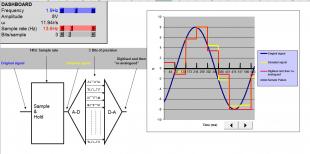Now, there's a lot going on here.
Suggested experiments ...
- Set the signal frequency to 3Hz.
- Set the Bits/sample to 12 bits (ie very accurate A-D conversion)
- Set the sampling frequency to 50Hz (ie far greater than the signal frequency)
The sampled signal is pretty good, isn't it? - Lower the sample frequency until it reaches 10Hz.
Signal looks pretty horrid, but is is going up and down the correct number of times! - Lower the sample frequency gradually until it reaches 6Hz. This is JUST twice the signal frequency. What has happened?
- Take the sample frequency back up to 50Hz.
- Now let's muck about with the bits/sample. Reduce it from 12 to 4 - that means that we only have 2^4 = 16 values of voltage available. Some distortion?
- Now really go for it - 2 bits/sample = 4 values of voltage. Pretty nasty, unless all you need to get from this is a frequency. This would sound really horrid!

Basics of Electronics ... a "Toybox" by Alan Murray, University of Edinburgh is licensed under a Creative Commons Attribution-NonCommercial-ShareAlike 4.0 International License.



